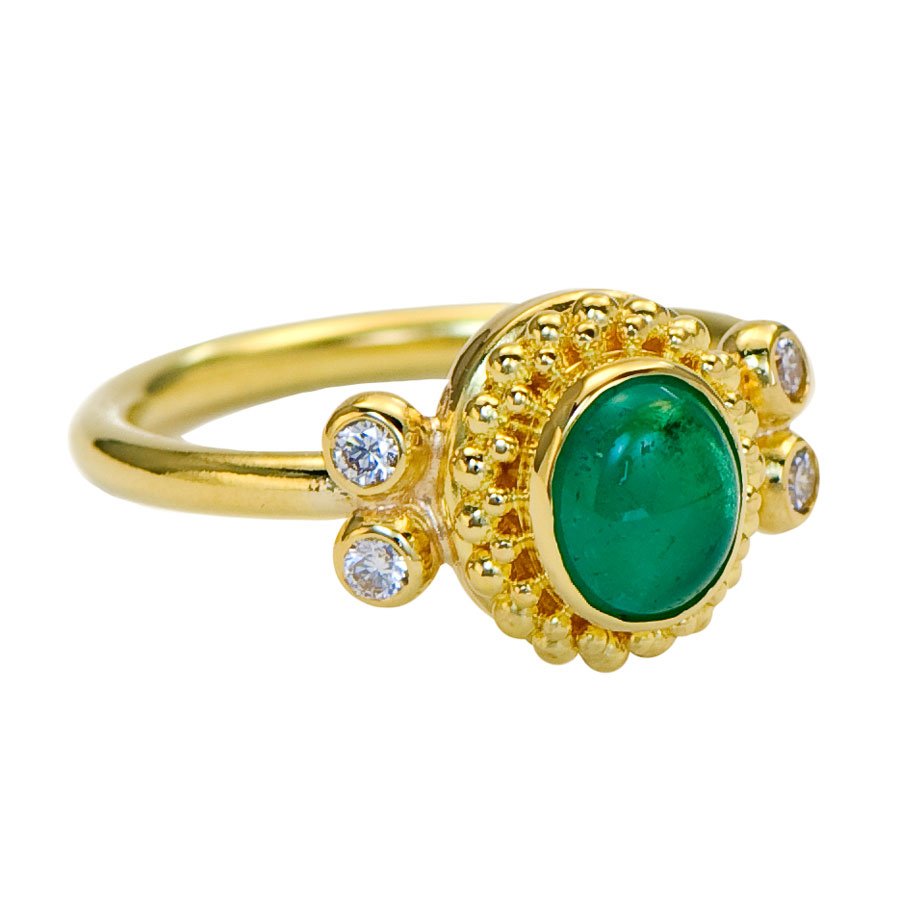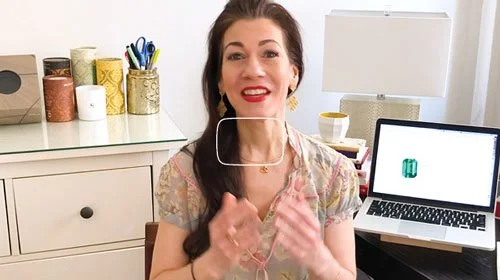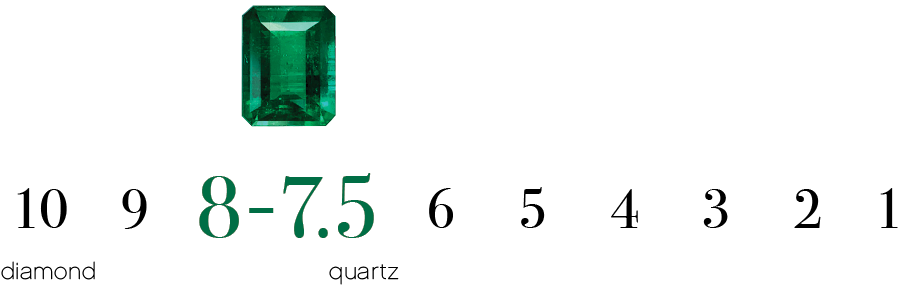EMERALD JEWELRY WITH INTENTION AND CONNECTION
Why is EMERALD desirable?
Emeralds naturally have a gorgeous green “jardin”. The most prized have very few inclusions and are the rarest of the rare. I believe these perfect imperfections are what make each emerald uniquely beautiful - just like us!
Get the skinny on emerald and shop a curation of intentional jewelry, thoughtfully designed by women…

SHOP
DESIGNER EMERALD JEWELRY
What are the metaphysical properties of emeralds?
This gemstone attracts prosperity, balance, and inspiration. It is also associated with hope, compassion, revitalization, and wisdom.
Just as our ancient ancestors believed gemstones were imbued with special properties, such as protection, wisdom, or courage, today we are empowered by the metaphysical properties of gemstones to manifest what we wish to create.
You may be interested in our guide to manifest your intentions with gemstones and jewelry!
WHAT IS EMERALD?
Across our great, ancient civilizations, emerald was the most prized among gemstones, as it was believed to bring about calm, protection, and fidelity.
The earliest archeological evidence of mining exists in Egypt around 500 BC. With the Spanish conquest in the 1520s, an abundant source of higher-quality gems became accessible to the wider world in present-day Colombia.
Aristotle suggested it could “comfort and soothe the eyes” (and improve one’s status). Cleopatra famously loved emeralds, as did royal families from India to Iran to Russia. It was a sacred stone to Mesoamerican tribes such as the Olmec, Inca, Aztec, and Maya. They were an offering to their gods and have been excavated in burials.
We’ve outlined points to help you understand value and what to ask about emerald jewelry.
Seeking personalized shopping support when investing in your jewelry collection?
Get expert guidance for jewelry with intention and connection!
Things to know about emeralds - and discerning jewelry designed by WOMEN!
What to know about EMERALD!
The “ideal” emerald in terms of what the market values most has a deep green to bluish-green hue, with few inclusions. Emeralds naturally have inclusions (material that is trapped within a mineral such as liquid, gas bubbles, fractures, or other minerals), and treatment with oil or filler is a common, acceptable practice.
It is a member of the beryl family, alongside aquamarine, morganite, and heliodor (golden beryl). While the market prefers to classify emeralds as exhibiting rich, dark greens to bluish-greens, light green can be incredibly enchanting.
The topic of inclusions is one of my favorites because I believe they are what make a gemstone uniquely beautiful - just like each of us. With emerald, inclusions are known as “jardin” (French for garden) and are always worthy of celebrating!
DO YOU KNOW THAT EMERALD HAS GORGEOUS DOPPELGÄNGERS?
As a precious gemstone, emerald is among the most valuable gemstones. Chrome tourmaline and tsavorite garnet can be more attainable options that are (obviously) equally gorgeous!
SHOP
EMERALD HUED JEWELRY
The origin of gemstones: TRACEABILITY
I believe in humanizing supply chains as much as possible to ensure you have certainty your jewelry investment aligns with your values. Just as we know where our food comes from and who made our clothes, why not jewelry?
All The Brilliants is a proud member of the United Nations Fashion and Lifestyle network, aiming to accelerate solutions for achieving the Sustainable Development Goals (SDGs) by engaging the fashion and lifestyle sectors, fostering collaboration, and promoting sustainability.
What does sustainably and ethically sourced jewelry mean?
Women and men at the forefront of this global conversation will have slightly different perspectives, but there is a shared ethos: responsible sourcing.
This encompasses traceability, conflict-free, protecting people, their skills, and the environment - be it land or sea.
Where are emeralds found?
This gemstone can be found throughout the world - the most prized of which is from Colombia. That said, Zambian gems are turning heads!
COLOMBIA: Fine emeralds from Colombia have an established history and reputation in the market. They are revered for their vivid, leafy green color and clarity. Because of the way the color is distributed in the material, expertise and precision are required during the cutting process - making it more labor-intensive.
ZAMBIA: Zambian emeralds caused a sensation in 1976. Because of their high iron content, they exhibit a desirable vivid bluish-green color.
OTHER COUNTRIES: Brazil, Pakistan, Afghanistan, Australia, United States, Russia, and beyond.
INTERESTED IN PERSONALIZED SHOPPING SUPPORT?
As your fine jewelry guide, I protect your energy and provide peace of mind when investing in jewelry with intention and connection.
Whether you are the chairwoman of the board, the CEO of your household, or a highly visible entrepreneur, the jewelry you choose can ensure you feel confident, seen, and connected with your inner power.
Let’s connect for intentional jewelry that brings what’s inside out!
Oil treatment of emeralds
Because this gemstone has light or heavy inclusions, the material is routinely treated with either oil or other fracture-filling substances, such as waxes or resins. This diminishes the appearance of inclusions and can enhance or stabilize durability. Such treatment is detectable by gemologists and the degree of treatment would be noted on the gemological report from a credentialed lab.
Knowledge is power and while the above treatment is acceptable, it does impact market value.
The MOHS SCALE: How hard is EMERALD?
hard, but brittle because of naturally occurring inclusions
The Mohs scale of hardness is important to consider when choosing a particular stone for a particular kind of wear.
It is the degree of mineral “hardness”, measured by the resistance which a smooth surface offers to abrasion: 1 (soft) to 10 (hard). For example, an 8 will scratch a gemstone that is a 7 or below. Simply put, the softer the stone, the more careful you need to be about wearing that stone in jewelry that may be exposed to more wear.
Does emerald scratch easily?
YES!
This is a question you’re most likely to ask when buying gemstones and jewelry. Knowing how hard emerald is (or any other stone) will help you to determine whether it is an everyday gemstone or an occasional piece.
While still in the hard range at 7.5 - 8, it is a brittle crystal. Inclusions are common and completely acceptable in this material. Highly fractured stones, particularly those with fractures on the corners, are more susceptible to damage from everyday wear and accidental bumps. Choosing kinds of jewelry (i.e. cocktail rings, necklaces, or earrings) that will encounter less contact with harder surfaces is a good option for emerald. As alluring as it is, this stone is not ideal for an engagement ring.
How to care for emerald jewelry
A few jewelry care basics can keep your pieces looking their best, avoid damage and loss of gemstones.
WEAR: When dressing for day or night, jewelry should be the last thing on and the first thing off. Contact with chemicals such as fragrance, hairspray, nail polish remover, household cleaners, and chlorine can harm jewelry. Especially emeralds, as these can damage any enhancements or oiling.
Remove jewelry when cleaning, gardening, swimming, or playing sports, as contact with hard surfaces can scratch, damage, or loosen stones in prongs.
CHECK SETTINGS AND STONES: Inspect jewelry before wearing it to check if the stones are chipped, loose, or rattle in settings.
CLEANING: All precious metals, gemstones, and pearls should be cleaned regularly, but require different care. For example, ultrasonic cleaners can crack emeralds - and shatter pearls and opals. Because emeralds are often treated, such intense cleaning can cause the oil or filler to leach out and will diminish the original appearance of the stone.
● For gemstones on the Mohs scale at 7 or above, a simple cleaning solution is warm water with mild soap and a soft toothbrush. For those at 6 or below, replace the toothbrush with a tightly woven microfiber or other soft cloth.
● A soft polishing cloth will keep any precious metal looking its best.
● Take any investment pieces to a trustworthy professional jeweler once a year for a thorough cleaning and inspection.
● See our full guide to How To Clean Fine Jewelry.
STORAGE: Keep jewelry individually stored in a pouch or box to avoid scratches and abrasions from other gemstones and metal, as well as general tangles and dents.
INSURANCE: For any jewelry of significant value, be sure to have it appraised, file any provenance and gemstone report in a secure place, and be sure to have it insured.
JOIN OUR COMMUNITY OF WOMEN LEADERS
Sign up: Step into our inner circle for style tips to amplify your visibility, inspiring conversations with women leaders, and insider access to jewelry that celebrates your story and inner power.























